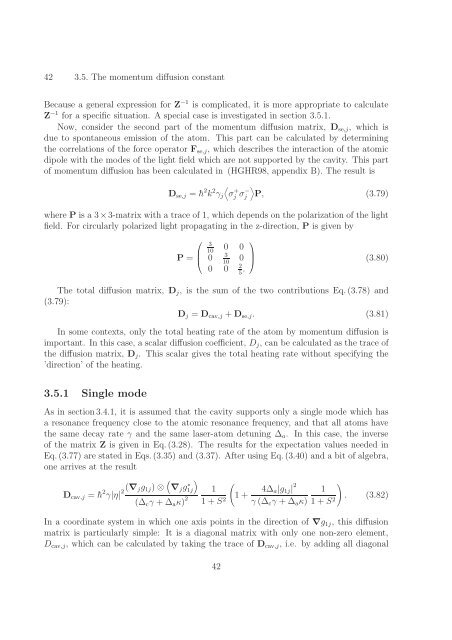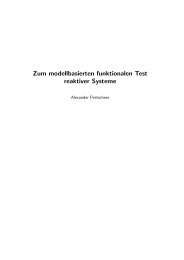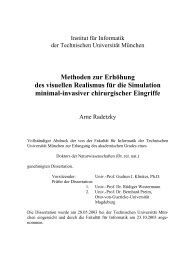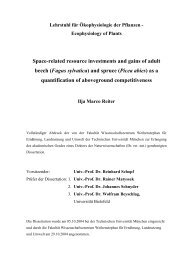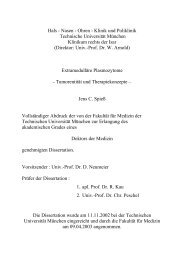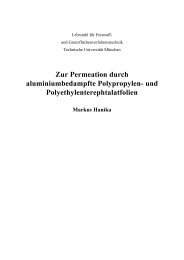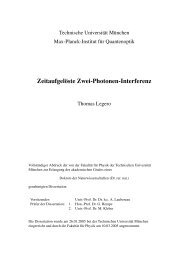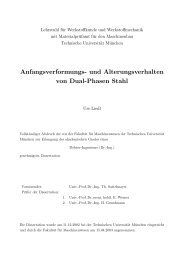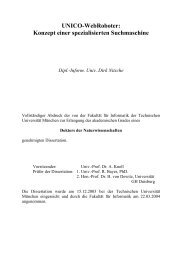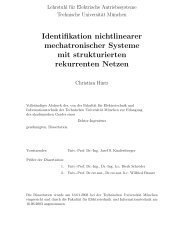Controlling the motion of an atom in an optical cavity
Controlling the motion of an atom in an optical cavity
Controlling the motion of an atom in an optical cavity
Create successful ePaper yourself
Turn your PDF publications into a flip-book with our unique Google optimized e-Paper software.
42 3.5. The momentum diffusion const<strong>an</strong>t<br />
Because a general expression for Z −1 is complicated, it is more appropriate to calculate<br />
Z −1 for a specific situation. A special case is <strong>in</strong>vestigated <strong>in</strong> section 3.5.1.<br />
Now, consider <strong>the</strong> second part <strong>of</strong> <strong>the</strong> momentum diffusion matrix, Dse,j, which is<br />
due to spont<strong>an</strong>eous emission <strong>of</strong> <strong>the</strong> <strong>atom</strong>. This part c<strong>an</strong> be calculated by determ<strong>in</strong><strong>in</strong>g<br />
<strong>the</strong> correlations <strong>of</strong> <strong>the</strong> force operator Fse,j, which describes <strong>the</strong> <strong>in</strong>teraction <strong>of</strong> <strong>the</strong> <strong>atom</strong>ic<br />
dipole with <strong>the</strong> modes <strong>of</strong> <strong>the</strong> light field which are not supported by <strong>the</strong> <strong>cavity</strong>. This part<br />
<strong>of</strong> momentum diffusion has been calculated <strong>in</strong> (HGHR98, appendix B). The result is<br />
Dse,j =¯h 2 k 2 γj<br />
<br />
σ + j σ− <br />
j P, (3.79)<br />
where P is a 3 × 3-matrix with a trace <strong>of</strong> 1, which depends on <strong>the</strong> polarization <strong>of</strong> <strong>the</strong> light<br />
field. For circularly polarized light propagat<strong>in</strong>g <strong>in</strong> <strong>the</strong> z-direction, P is given by<br />
⎛<br />
3 0 0<br />
10<br />
⎜ 3<br />
P = ⎝ 0 0 10<br />
2<br />
0 0 5 .<br />
⎞<br />
⎟<br />
⎠ (3.80)<br />
The total diffusion matrix, Dj, is <strong>the</strong> sum <strong>of</strong> <strong>the</strong> two contributions Eq. (3.78) <strong>an</strong>d<br />
(3.79):<br />
Dj = Dcav,j + Dse,j. (3.81)<br />
In some contexts, only <strong>the</strong> total heat<strong>in</strong>g rate <strong>of</strong> <strong>the</strong> <strong>atom</strong> by momentum diffusion is<br />
import<strong>an</strong>t. In this case, a scalar diffusion coefficient, Dj, c<strong>an</strong> be calculated as <strong>the</strong> trace <strong>of</strong><br />
<strong>the</strong> diffusion matrix, Dj. This scalar gives <strong>the</strong> total heat<strong>in</strong>g rate without specify<strong>in</strong>g <strong>the</strong><br />
’direction’ <strong>of</strong> <strong>the</strong> heat<strong>in</strong>g.<br />
3.5.1 S<strong>in</strong>gle mode<br />
As <strong>in</strong> section 3.4.1, it is assumed that <strong>the</strong> <strong>cavity</strong> supports only a s<strong>in</strong>gle mode which has<br />
a reson<strong>an</strong>ce frequency close to <strong>the</strong> <strong>atom</strong>ic reson<strong>an</strong>ce frequency, <strong>an</strong>d that all <strong>atom</strong>s have<br />
<strong>the</strong> same decay rate γ <strong>an</strong>d <strong>the</strong> same laser-<strong>atom</strong> detun<strong>in</strong>g ∆a. In this case, <strong>the</strong> <strong>in</strong>verse<br />
<strong>of</strong> <strong>the</strong> matrix Z is given <strong>in</strong> Eq. (3.28). The results for <strong>the</strong> expectation values needed <strong>in</strong><br />
Eq. (3.77) are stated <strong>in</strong> Eqs. (3.35) <strong>an</strong>d (3.37). After us<strong>in</strong>g Eq. (3.40) <strong>an</strong>d a bit <strong>of</strong> algebra,<br />
one arrives at <strong>the</strong> result<br />
Dcav,j =¯h 2 γ|η| 2 (∇jg1j) ⊗ <br />
∇jg ∗ <br />
1j<br />
(∆cγ +∆aκ) 2<br />
1<br />
1+S2 <br />
1+<br />
4∆a|g1j| 2<br />
γ (∆cγ +∆aκ)<br />
1<br />
1+S2 <br />
. (3.82)<br />
In a coord<strong>in</strong>ate system <strong>in</strong> which one axis po<strong>in</strong>ts <strong>in</strong> <strong>the</strong> direction <strong>of</strong> ∇g1j, this diffusion<br />
matrix is particularly simple: It is a diagonal matrix with only one non-zero element,<br />
Dcav,j, which c<strong>an</strong> be calculated by tak<strong>in</strong>g <strong>the</strong> trace <strong>of</strong> Dcav,j, i.e. by add<strong>in</strong>g all diagonal<br />
42


